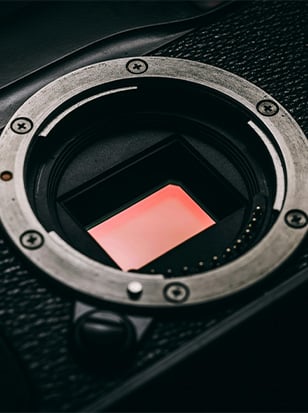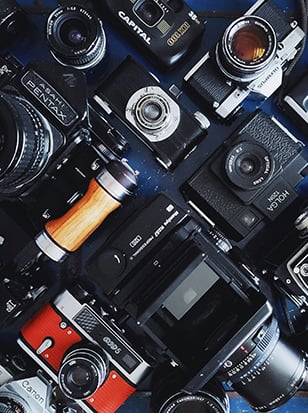
We’ve seen some pretty significant launches this month. While February last year saw the highly-anticipated and still pre-orderable Fujifilm X100VI, this year, we have what could be the ultimate hybrid camera from Panasonic. The other camera body released this month comes from lens experts Sigma.
From there we move on to camera lenses. Sigma introduces two telephoto lenses, and we see an almighty return from Zeiss, all of which expand options for mirrorless users. And finally, big hitters Sony offer two lenses from either end of the optical spectrum. But as always, remember, electronics stock can fluctuate rapidly. If something you’ve got your eye on isn’t available now, it likely will be soon, so keep checking back.
Let’s get down to business, shall we?
The long six-year wait for the Panasonic LUMIX S1R II is finally over. We took this highly anticipated camera to the Barbican in London to explore the incredible upgrades Panasonic has packed into this new model - which you can watch in the video below. Calling them "upgrades" almost doesn’t do it justice – this feels like an entirely new camera, equipped with an entire suite of new and advanced capabilities.
For hybrid shooters, this camera feels like an all-in-one solution. It’s powerful, versatile, and ready to deliver in any scenario. It has a 44.3MP full-frame BSI CMOS that delivers stunning image quality. But if that’s not enough, Panasonic has thrown in a handheld high-res mode that bumps your shots up to 177MP. Yes, handheld. No tripod needed.
Autofocus gets a serious upgrade too, with 779-point Phase Hybrid AF and AI-powered subject tracking. Whether you're shooting fast-moving wildlife or unpredictable street scenes, this camera locks on and doesn’t let go. And with 40fps blackout-free burst shooting (plus a 1.5s pre-burst feature), you won’t miss a moment.
Video is where things get even more interesting. The S1R II is the first Lumix camera to offer 8K 30p 10-bit internal recording, plus 5.8K Apple ProRes RAW HQ. And if you grab the firmware update, you unlock 8.1K Open Gate recording – perfect for reframing shots in post. On top of that, Active I.S., Dual I.S. 2, and E.I.S. work together to keep footage smooth, even handheld. Be sure to go read out the full product page write-up here.
Arriving as Sony’s farthest-reaching telephoto lens, the Sony FE 400-800mm f6.3-8 G OSS lens offers incredible reach and impressive optical performance, all in a well-balanced, internally zooming body. Its 27-element construction minimises chromatic aberration, while the two XD linear motors ensure fast, precise autofocus – perfect for tracking fast-moving subjects. Add Optical SteadyShot stabilisation and robust weather sealing, and you’ve got a lens that’s ready for all things outdoors. Oh, and it’s relatively lightweight and compact considering its class, weighing just 2.4kg.
That said, it’s not exactly small or cheap. If you’re after something more portable, Sony’s 200-600mm might be a better fit – but it won’t get you to 800mm, let alone 1600mm with a teleconverter. With all that said, this lens is going to be a must-have for wildlife and sports photographers.
Next up is the Sony FE 16mm f1.8 G lens – a lens that makes you feel like you can fit everything into the frame. It’s part of Sony’s G lineup, which sits just below G Master but still meets exacting standards with premium craftsmanship. The standout feature? That f1.8 aperture. It’s rare for a 16mm lens and opens up a huge range of creative possibilities. You get greater flexibility in low light, but you can also experiment with depth of field in ways you wouldn’t expect from an ultra-wide lens.
The close 15cm minimum focusing distance, combined with that wide aperture, makes this lens incredibly versatile. One moment, you’re capturing wide landscapes or night skies; the next, you’re drawing in on fine details and textures up close. It’s also great for video. The lightweight design and internal focusing keep it well-balanced on a gimbal, while the linear AF motors deliver fast, quiet autofocus with virtually no focus breathing.
Next up is Sigma, and their latest camera body: the Sigma bf.
This full-frame 24MP camera is supposedly all about stripping photography back, radically changing how you approach shooting. For those used to feature-packed modern cameras, it might feel a bit strange at first. The design is minimalist – just a back dial, three buttons, a fixed LCD screen, and a tiny secondary screen that shows the setting you’re adjusting. Everything is designed to be controlled with your thumb. From the back, it resembles a compact camera from the early 2000s; from the front, it’s sleek, sharp, and almost Apple-like.
There are no memory card slots – instead, you get 230GB of internal storage, accessible via a single USB-C port. There’s no hotshoe, only one strap lug, and no EVF. You do get a tripod thread and a replaceable battery, but that’s about it.
Despite being marketed as a photo-first camera, it does offer video, capturing up to 6K in H.264 or H.265 compression. However, without a mic or headphone jack, it's clear that video is more of a secondary feature. The camera also relies solely on an electronic shutter – no mechanical option.
So, what’s the deal with this camera? Honestly, we’ve got more questions than answers. But we’re intrigued. And, we’re excited to see how it performs now it’s out in the wild.
Available for: L-mount, Sony-E and Fujifilm X-Mount
Back to lenses, Sigma’s 16-300mm f3.5-6.7 DC OS Contemporary lens is going to be a real option for a lot of people. Covering a huge range, this contemporary series lens is the world’s first mirrorless lens with an 18.8x zoom ratio. This is clearly an all-rounder lens, offering that long 300mm reach as well as a 1:2 magnification ratio for detailed macro work. It has a high-speed HLA motor that ensures fast, accurate autofocus for action and wildlife photography. And with up to 6 stops of optical stabilisation, you can shoot handheld, even in tricky lighting conditions. It’s also super-cheap for what it is. At the time of writing, it’s just £599. What’s there not to love?
Panasonic has dropped what it claims to be the world's smallest and lightest 7x zoom full-frame lens. The Panasonic Lumix S 28-200mm f4-7.1 Macro OIS Lens is equipped with a wide focal range that can cater to almost any shooting scenario. Because of this, this lens is ideal for travel photography when you don’t want to bring lots of equipment and keep your weight down. This type of compact and always-on-the-camera lens is often met with criticism but this lens seems to perform very well — surprisingly so! This is definitely a lens for a person who wants a lens that can do it all.
50mm: Also available for Canon RF and Nikon Z
85mm: Also available for Canon RF and Nikon Z
Finally, we have the return of Zeiss. They’ve brought us two lenses designed for photographers and videographers wanting full manual control. They feature a long focus throw, a de-click aperture ring, and engraved scales, everything needed for honing your image-making. Optically, the Otus ML lenses deliver the classic Zeiss look. The images are sharp, detailed images rich in contrast with smooth, circular bokeh. The Sonnar design and aspherical elements minimise distortion and aberrations, while the T* anti-reflective coating enhances contrast and reduces flare. Built with an all-metal, weather-sealed body, they’re made to withstand tough shooting conditions while maintaining a sleek, professional feel.
About the Author
Leo White has been part of the Wex Photo Video team since 2018, taking on roles from the contact centre to the product setup team. Holding both a BA and an MA in photography, Leo brings a wealth of expertise he’s always ready to share.
Sign up for our newsletter today!
- Subscribe for exclusive discounts and special offers
- Receive our monthly content roundups
- Get the latest news and know-how from our experts

















